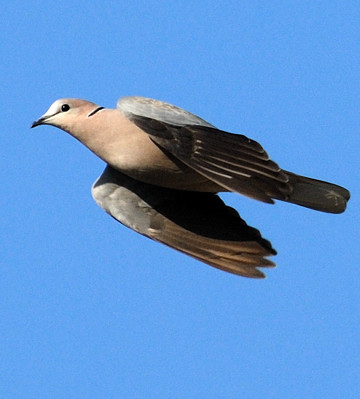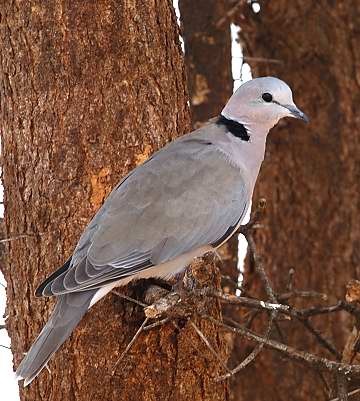 |
| Ring-necked Dove (Cape Turtle Dove) in Tarangire, photo from here |
The sound of the Ring-necked Dove is one of the constant backgrounds to a safari in the bush (if you don't know it, the "work harder, drink lager" refrain is available here) and it's actually this distinctive song that is the easiest way to identify the species from among a number of confusingly similar species. The ring-necked dove is a medium sized, grey dove. It has a black collar around the back of its neck and is a paler grey white below, with pale edges to its tail. Unfortunately, that description is would cover just about any of the close relatives of this species, and (as well as listening to the calls) you need to look rather closer to identify the species correctly. Firstly, look at the eye: if it is dark and not obviously surrounded by bare skin, you're probably looking at a Ring-necked Dove. White (not grey) edges to the tail and a generally pale grey would confirm the identity in eastern and southern Africa. If the eye is pale yellowish, with a red ring around it and there's a warmer brownish wash to the back and neck that contrasts with a grey head, you're probably looking at an African Mourning Dove (call) and if its got a dark eye in a bare purple/red patch of skin, and is overall darker looking, with grey tail edges, you're looking at a Red-eyed Dove (call: "I am a Red-eyed Dove").
 |
| Another borrowed picture, fora grey bird, they are rather attractive! |
So, once the identification is over, what is there interesting to say about this species. Well, I think there are two things to point out generally about doves, one of which I've mentioned before on the blog, the fact they're one of the few bird groups that can drink without lifting their heads (see the post here for the full story!). The other interesting thing is their ability to feed their young chicks what is called 'pigeon milk' for the first few days after hatching. Essentially, adult doves of both sex produce a substance in their crop that is fed to young chicks in place of normal food. Although this substance has evolved completely independently from mammalian milk, it has a number of remarkable similarities which has been the subject of a couple of interesting recent papers, starting from the extraordinary fact that the process is all regulated by exactly the same hormone (prolactin). Whilst mammalian milk is a liquid secretion that is probably a modified form of sweat (nice, huh?), crop milk is actually made of specially grown cells that are shed from the lining of the crop (for a particularly gruesome picture of dissected 'lactating crops, have a look here...). That difference aside, the content is pretty similar: a very high component of protein (around 60%) and the rest of the solid matter being mostly fat. Amazingly, the similarities don't end there - an important function of mammalian milk (and probably the main reason why formula isn't as good for babies as breast milk) is to pass on antibodies to the baby, which help protect the baby as it's immune system develops. And it turns out that exactly the same things happen in crop milk - chickens fed on pigeon milk developed a stronger and better functioning immune system than those fed on a similarly nutritious diet, but without the antibodies. Moreover, mammalian milk also includes bacteria, which effectively 'seed' the guts with useful bacteria that help digestion - the same is true of pigeon milk. It seems that 'milk' has evolved multiple times with parallel results - it isn't only pigeons that produce cop milk, flamingos and (male) penguins do too, but it is rather remarkable!
These general facts about pigeons are certainly interesting, but not specific to the ring-necked dove. The most interesting thing I know about ring-necked doves in particular, is that in some areas of Uganda they are perhaps merging into a new, hybrid species. Often, two species that are closely related and usually live in separate regions illustrate an interesting process known as "Reproductive character displacement" if and when they later come back into contact with one another. This is the process by which two, usually closely related, species appear more different in the zone of overlap, than in areas where only one of the two species lives. Often closely related species can hybridise (male and female of two different species will mate and produce young, the hybrids), but these hybrids are usually not as fertile as 'pure' individuals, and may have other problems too. So it's in the interests of the two species to be able to accurately identify mates of their own species. Where all the grey doves in an area are of one species, you don't need to discriminate much to find a mate of the right species, but where you overlap with a closely related species, you need to be more careful about who you mate with, and evolution might tend to exaggerate whatever slight differences exist. If, for example, one species has a slightly higher pitched call than the other, where the two overlap this difference may be much greater than elsewhere. If, however, there's little cost to hybridisation (which sometimes occurs if the hybrids themselves are able to mate with other hybrids), the opposite can occur and a new species with features of both can occur - it seems a relatively rare way of forming new species (except perhaps in plants), but might just be happening with these doves at the moment. All very interesting...
So, hope that's something interesting about ring-necked doves. Baglafecht weavers are next...
Main References:
Gillespie, M., Haring, V., McColl, K., Monaghan, P., Donald, J., Nicholas, K., Moore, R., & Crowley, T. (2011). Histological and global gene expression analysis of the 'lactating' pigeon crop BMC Genomics, 12 (1) DOI: 10.1186/1471-2164-12-452
The pigeon order is a very interesting order and its very diverse. I have always found them interesting. Often they are the most abundant species in the area and are invasive species (Eurasian collared doves in Colorado) while other are endangered or extinct (passenger pigeons). They are a very interesting group of birds and in Colorado in the summer i really enjoy watching them.
ReplyDelete